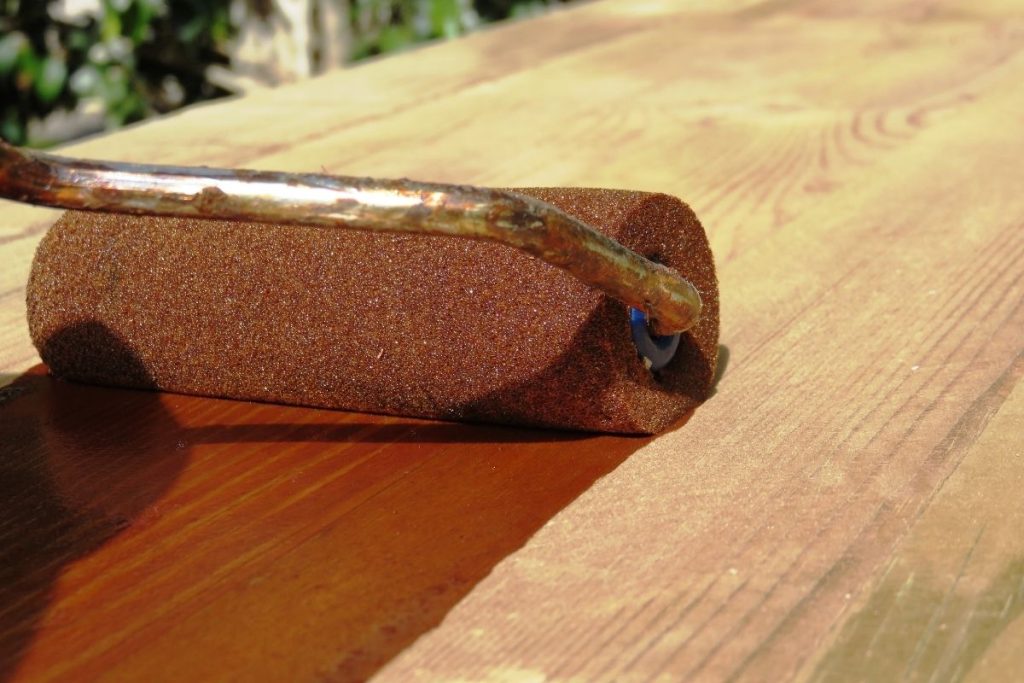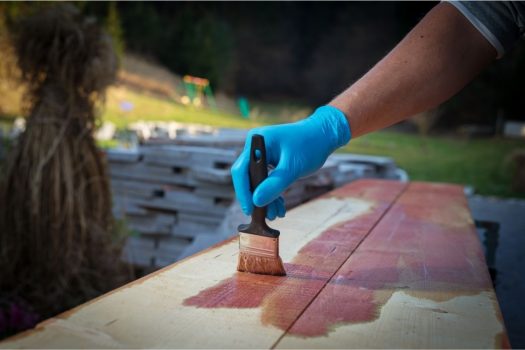Contents
If you’re looking to change the color of some of your wooden furniture – or any piece of wood you might have, for that matter – then a good stain can be one of the most attractive ways of doing it!
Unlike paints, which sit on top of the wood and cover the surface completely, stains soak into the wood, not just coloring but highlighting the wood’s natural grain.
This is why stains are so popular – they provide a much more traditional and natural look than paint ever can.
There are some misconceptions about wood stain, and some mistakes that are often made when using it. With a few handy hints, you can avoid these mistakes altogether – and bust through any myths you might have heard about wood stain!
Myth: Wood Stain Is Just Like Paint
Wood stain and paint do different jobs and work in different ways. While they share a broad similarity in that they’re both ways of changing the look of your wood, they also have significant differences.
Paint sits on top of the wood, forming a layer that covers the wood. Paint can, of course, soak into the wood sometimes, particularly with water-based paints, but its primary purpose is to sit on top of the wood. That’s why you can sand paint off relatively easily – and also why it flakes off sometimes.
However, a wood stain is a color that soaks into the wood, revealing the natural grain. It doesn’t cover the wood like paint or lacquer does – it soaks in, and once it’s in the wood, you’re not really getting it out easily. It’ll require a fair bit of work – and may even be impossible to sand out completely in some cases.
Myth: Wood Stain Protects Wood
Wood stain offers no protection to the wood, as it’s just a way of coloring it. Unlike paint or lacquer, which build layers over the wood, stain soaks into the wood fibers. Therefore, it can’t provide any barrier against the elements or bumps and scrapes.
A lacquered finish on your wood will protect it from spilled liquids, bumps, scrapes, ultraviolet light, and so on – but a stain won’t help against any of these things. Therefore, if you want to protect your wood, you’ll need to put some protective finish on it after you stain it.
You don’t need to stain wood unless you want to change the color of it – of course, it’s perfect for that, and you can make a piece of wood look drastically different with a good stain. They can bring wood to life!
Myth: You Can Sand The Stain Off If You Don’t Like It
This isn’t 100% a myth, but it’s one of those things that falls firmly into the “good luck with that” camp of ideas. It’s not impossible to get rid of wood stain, but depending on how deeply absorbed into the wood the stain is, it can be difficult enough that it’s just not worth the trouble.
If you can get the stain gone with sanding to a level you’re happy with, that’s fantastic! But it’s possible that getting to that stage with certain stains and woods would require so much sanding that you’d be better off using a plane and just outright cutting the surface off the wood!
That’s a half-joke – there are certain circumstances in which removing a stain from wood can only really be done by destructive methods!
Mistake: Not Sanding

Painting and staining have some similarities, however – they both need prep work to be done before you can begin!
You must take the time to thoroughly sand down the surface you’re working on when doing anything like this, whether it’s staining or painting.
You need to do this to get the surface in the proper condition for taking paint or a stain. This is called building a key – and it’s a key part of getting the job right!
If you don’t take the time to do this, you’re just making the job harder for yourself in the long run – and you’re running the risk of getting a worse result than if you’d spent the time to sand the workpiece down properly.
It’s no fun at all, it takes time and effort, and you have to wear a mask and eye protection (especially important if you’re using a powered sander), but it’ll mean you’re on track to getting the best results. It’ll eliminate any noticeable scratches and open up the wood to accept stain better.
Mistake: Not Sealing
If you’re putting paint onto bare wood, you likely know already (or you should do!) that you should prime the wood before painting. As with sanding, it’s a key part of getting the best results – not least because it means you need fewer coats of your more expensive color paint!
You’ll need to do something similar when using wood stain for the best results. After you’ve finished sanding the wood down (and please take the time to sand your wood properly!), you should apply a wood conditioner or a sanding sealer.
This can help with getting the evenest coverage of your wood stain – failing to take this crucial step can result in a blotchy and uneven stain. Not something you want at all!
Mistake: Not Wiping
Again, wood stain isn’t the same as paint – so you can’t just apply it and leave it the same way you do with paint. After applying the stain, you need to ensure that you wipe any excess off with a clean, dry cloth.
If you don’t do this, your stain will dry unevenly – and you might have excess stain pooling on the surface of your wood. This can mean that your workpiece is sticky for days longer than it needs to be – because any stain that doesn’t get soaked into the wood isn’t going to dry easily!
Therefore, ensure you spend a few extra moments to eliminate any excess stain. It’s all about the details, remember – skipping important little steps like these is a surefire way to get a finished piece that’s far less than perfect.
Conclusion
There you have it – a quick and simple guide to common misconceptions and mistakes about wood stain. Hopefully, you’ll have found some helpful advice that you can use on your next wood staining project!







